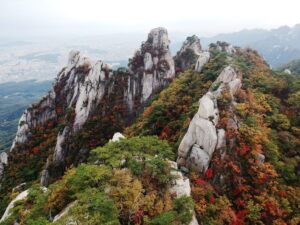I sit in my modest but comfortable room on an aromatic tatami mat that smells of herbs. I sip hot tea as I peer out my window into the motionless countryside. I listen. I hear only the quiet chirping of crickets.
This isn’t the Japan I have gotten to know over the past few years. This Japan isn’t flashy or loud or brimming with maid cafes or Pachinko arcades. No. This Japan is mysterious and magical and shrouded in mist, a Japan I thought was long-gone and only existed in the movies.
This small village of 40 residents is so sacred, in fact, that thousands of pilgrims flock here each year to begin their trek on the Kumano Kudo, a network of forested trails that stretch across the Kii peninsula, important routes in the Shinto and Buddhism religions. Temples and shrines dot the hallowed courses and provide an interesting glimpse into Japan’s religious history and culture.
While many visitors still come here for the spiritual experience, others make the healing journey to soak up the natural beauty of the Japanese countryside, made up of towering Cedars, rolling green hills and breathtaking waterfalls. In addition to the scenery, three elements make the Kumano Kudo experience truly memorable: Wakayama cuisine, hot springs and traditional accommodations. Fortunately for me, my ryokan (Japanese inn) is known as the best in the area to experience all three.
I was greeted in the neighboring city of Takijiri by Jian (or John, to English speakers) who was quick to introduce himself as the “producer” of Kiri-no-Sato Takahara Hotel. Although I had never heard of such a title, I would soon learn why he called himself this. Jian loaded my bags into his car and we were soon on our way to the hotel, as public transportation is non-existent. Jian explained everything about the area as we drove over streams and around sharp turns, pointing out the local vegetables that the hotel uses in its cuisine. When we reached Takahara, it became apparent that Jian knew everyone in the village; elderly farmers waved at him with toothy grins as we passed.
When we arrived, Jian gave me the grand tour of Kiri-no-Sato, greeting each hotel guest by name as we passed. The reception area and dining room boasted high ceilings supported by wooden beams, typical of a mountain lodge, and an outdoor patio furnished with picnic tables, lanterns and even a telescope was an extension of the common area. It was here that local fishermen, who had just delivered a recent catch, chatted over a beer, next to a group of conversing guests who had presumably been strangers just a few hours before. I was already loving the community vibe of the hotel and I hadn’t even seen my room.
When I did, however, I was sold.
I stayed in a “Western” style room, named so because guests sleep on beds instead of the floor, but despite its name, the room oozed Japanese charm. The delicate sliding doors, the tasteful Asian art and the tea set waiting to be used immediately put me at ease. Still, the highlight of the room was the view of the majestic Haetenasi Mountain range, known particularly for its mists that settle into the valley in the mornings. Unlike most hotels, each of Kiri-no-Sato’s rooms offer this impressive view and boast a small terrace, perfect perches for soaking up the beauty.
Soon it was dinner time, a meal I was anxiously awaiting. Kiri-no-Sato places a great emphasis on supporting local organic farmers so it sources only organic ingredients for its meals (breakfast and dinner are included in the price). Farmers and fishermen deliver food daily and Jian and his staff plan the menus- mostly Japanese fare with an international twist- based on what is delivered… quite a task in my book.
I took a seat in the dining room and my eyes quickly widened at the sight in front of me. Tiny, colorful morsels- none of which I could identify- made my mouth water but I managed to sit calmly while Jian explained to me what each was.
First I tried the pickled sansai, or mountain vegetables, which are picked in the spring, fermented and consumed throughout the year, much like Korea’s kimchi. The flavors of these vegetables, however, was lighter and the texture crunchier; while each had a distinctively different taste, not one was overpowering enough to alter another’s flavor. I followed the pickles with a soft, sweet deep fried tofu and mountain potato dish and a side of chewy taro root. River crab, eggplant with herbs, and gelatinous peanut followed.
When I took a bite of the tataki white bonito, which was slightly charred on the outside but sashimi-like on the inside, I involuntarily let out a string of expletives. Never before had I tasted such a clean, well-balanced fish dish. The local Kumano beef, cooked table-side and topped with succulent mushrooms, practically melted in my mouth and had my eyes rolling into the back of my head. And this isn’t even a slight exaggeration.
At some point during the middle of my meal, I let my attention wander from the food for a brief moment to look at the other diners around me and noticed there were three other single travelers. Yet not a one was distracting themselves as we so easily do while eating alone. No books, no phones. They were genuinely focused on their dinner, admiring the meal as if it were art, which in a way, it was.
Just when I thought the meal was over, salted mackerel, roasted chestnuts and chawanmushi, a savory egg custard of mushrooms and shrimp, were laid before me. Dessert was a refreshing berry sorbet. As if I weren’t already in culinary nirvana, Jian poured me an icy glass of homemade ume (Japanese pear) wine. It had enough kick to get me buzzed, but it but was still crisp and sweet, a perfect choice to wrap up a dinner.
Although I could’ve easily settled into a food coma right then and there, I was eager to take advantage of Kiri-no-Sato’s bath facilities. I donned my yukata (Japanese style robe) and headed to the women’s bath where I spent the rest of the evening soaking in the onsen’s rejuvenating water, which is shipped in daily from a local hot springs. It was heavenly and I imagine for those trekking the entirety of the Kumano Kodo, healing, too.
After an incredible sleep, I was awakened by the sound of gongs echoing from somewhere deep in the mountains. I watched the sky fill with the morning light as I made a pot of tea. I was still full from the night before, but not one to turn down a meal, I made my way to the dining room once again for breakfast.
Jian wished me good morning as he poured me a cup of strong organic coffee- good coffee- while a relaxing mix of Spanish music played in the background. (Unfortunately there were no Spanish guitar performances while I was there but it is said that locals like to give concerts from time to time at the hotel.)
A traditional Japanese breakfast spread was delivered dish by dish to the table: steamed rice, miso soup, rolled egg, fish and more pickled vegetables. Delicious and healthy… it’s no wonder Japan has the most centenarians in the world.
I wanted to stay at this quaint mountain-side haven forever. But I packed my bags, eager to explore some of the Kumano Kudo. Jian, the “producer”- the cook, the driver, the manager, the chef, the server, the event-planner, the travel guide, the eyes, the ears and the face of Kiri-no-Sato Takahara Hotel- offered to drive my bags down to Takijiri so they’d be waiting for me when I arrived, packed me a few bananas for the trek and wished me well on my way.
Yes, this was a different Japan. One less concerned with money, consumption and speed and more focused on finding joy in the simple things: a hot bath, a delectable meal, a sunset and a long walk in solitude. This was my kind of Japan.
More Information: Kiri-no-Sato Takahara Hotel
Address: 826 Takahara Nakahezi-cho Tanabe City, Wakayama, Japan
Phone Number: 0739-64-1900
Website: Click here
Price: Western style rooms 10,000 yen/person ($90 USD, double occupancy) or 11,000 yen/person ($100 USD,single occupancy). Prices include breakfast AND dinner. (What a bargain!) Family and group rooms are available. See website for pricing. TIP: Book your reservation through e-mail rather than a third party site to avoid service charges.
To Get There: From Osaka, take the JR Shin-Osaka train to Kii-Tanabe Station (approximately 2 hours). From the station exit, take the Ryujin Bus (bus stop #2) bound for Hongu-Kumano. Get off at Takijiri Station (about 45 minutes). From the tourist center at the bus stop, you can call Jian and he will pick you up.
Words and photos by Mimsie Ladner of Seoul Searching. Content may not be reproduced unless authorized.

